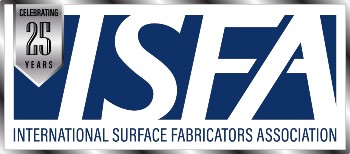Quartz Countertops
Clean and Durable: The Value of Quartz in Today’s Environment
With safety and cleanliness at the forefront of many people’s minds in today’s environment, quartz surfacing fills a need for those wanting a durable and clean surface that also offers numerous design choices. Not only is it is highly durable and stain-resistant, when properly cleaned it does not harbor bacteria, mold or other fungus making it very hygienic. Quartz surfacing consists largely of extremely hard natural quartz particles, so it is scratch-resistant, making it a good fit for a variety of residential and commercial applications. With an extensive array of available looks, ranging from solid colors to stone-like patterns, a desired aesthetic is easily achieved when using quartz materials.
Silica Resources
OSHA - Silica resources from OSHA are available.
ISFA is also happy to partner with our associate members to further our efforts of silica safety education including training.
More About Quartz Surfacing
The quartz surfacing industry burst onto the scene almost concurrently with the popularity of natural stone in the last decade. As granite began to be used more, its maintenance issues became more apparent. Manufacturers responded by developing quartz surfacing to provide the consumer with a material that combined the best qualities of granite with those of solid surface.
Quartz countertops provide the look and durability of natural stone along with scratch resistance and heat resistance. They are also a sanitary nonporous surface that is less susceptible to staining and do not require sealing.
How It's Made
By weight, quartz surfacing is typically made up of 93 percent natural quartz and 7 percent bonding resins. It is manufactured through a process that uses vibration and compaction to condense and bond the quartz particles with the resin to form a slab hard, uniform and non-porous.
Manufacturing advancements have led to quartz surfacing with veins and patterns. It is important to view a large representation for veined aesthetic patterns, as veining may not always be revealed in a smaller sample. Many manufacturers offer full slab viewing either in person or on their website, to confirm patterning of these aesthetics.
Although there are several manufacturers of quartz surfacing around the world, most use the same or similar technology first developed and patented by the Italian company Breton in 1966.
In 1968, Breton began the first "Vacuum Vibro Mixer" plants, which made it possible to fabricate engineered quartz surfacing in large blocks and slabs. Throughout the 1970s and 1980s, Breton refined the technologies that are used now by almost all manufacturers worldwide.
Backed by The People Who Make it.
After the completed slabs are created and polished, final refinements are made and the slabs (typically in 2 or 3 cm) are then shipped out to distributors. Fabrication shops turn the slabs into finished countertops, based on consumer specifications. The manufacturers are so confident of the quartz surfacing product that most offer extensive warranties, something that is rarely found with natural stone.
Quartz Resources (PDF Documents)
The Manufacture and Install of Quartz Surfacing Countertops
The Care and Cleaning of Quartz Countertops
A Deeper Look at the Features of Quartz Surfacing
|
